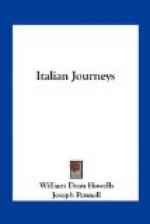II.
It was curious to pass, with the impression left by this costly and ingenious toy upon our minds, at once to the amphitheatre in Verona, which, next to the Coliseum, has, of all the works bequeathed us by the ancient Roman world, the greatest claim upon the wonder and imagination. Indeed, it makes even a stronger appeal to the fancy. We know who built the Coliseum, but in its unstoried origin, the Veronese arena has the mystery of the Pyramids. Was its founder Augustus, or Vitellus, or Antoninus, or Maximian, or the Republic of Verona? Nothing is certain but that it was conceived and reared by some mighty prince or people, and that it yet remains in such perfection that the great shows of two thousand years ago might take place in it to-day. It is so suggestive of the fierce and splendid spectacles of Roman times that the ring left by a modern circus on the arena, and absurdly dwarfed by the vast space of the oval, had an impertinence which we hotly resented, looking down on it from the highest grade of the interior. It then lay fifty feet below us, in the middle of an ellipse five hundred feet in length and four hundred in breadth, and capable of holding fifty thousand spectators. The seats that the multitudes pressed of old are perfect, yet; scarce a stone has been removed from the interior; the aedile and the prefect might take their places again in the balustraded tribunes above the great entrance at either end of the arena, and scarcely see that they were changed. Nay, the victims and the gladiators might return to the cells below the seats of the people, and not know they had left them for a day; the wild beasts might leap into the arena from dens as secure and strong as when first built. The ruin within seems only to begin with the aqueduct, which was used to flood the arena for the naval shows, but which is now choked with the dust of ages. Without, however, is plain enough the doom which is written against all the work of human hands, and which, unknown of the builders, is among the memorable things placed in the corner-stone of every edifice. Of the outer wall that rose high over the highest seats of the amphitheatre, and encircled it with stately corridors, giving it vaster amplitude and grace, the earthquake of six centuries ago spared only a fragment that now threatens above one of the narrow Veronese streets. Blacksmiths, wagon-makers, and workers in clangorous metals have




